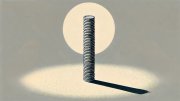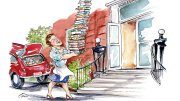Ever lost a coin toss? In theory, the odds could have gone your way or the other. The stakes may or may not have been low for you, but millions of dollars are regularly waged on the outcome of the Super Bowl coin toss. But what if a coin lands on its side, rather than either heads or tails? Then who emerges victorious?
In this mini-lecture, L. Mahadevan, de Valpine professor of applied mathematics, organismic and evolutionary biology, and physics, explores the probability of a coin toss in which the coin lands on its side, using it as a metaphor to discuss the role of chance and mathematics in understanding the world around us.
The probability of getting heads or tails when tossing a fair coin is often understood as 50-50. This notion is based on a critical assumption: the two sides of the coin are equally likely, and therefore each outcome—heads or tails—has a 50 percent chance of occurring.
Building on the simple coin toss, imagine gluing multiple coins together into a stack. As the stack becomes taller, the chance of landing on its side increases significantly, changing the probability dynamics completely.
As the stack grows taller, approaching a mile long, the likelihood of the coin landing on its side approaches nearly 100 percent. Thus, the probability of it landing on heads or tails reduces dramatically, until gravity defines it as zero.
As Mahadevan explains, it’s possible to create a coin where the probability of heads, tails, and landing on its side are equal. About eight coins glued together to form a stack will produce an equal probability for all three scenarios, with approximately a one-third chance of each outcome.
On one hand, the trajectory of a coin in flight is governed by Newton’s laws of motion, which can be precisely predicted. On the other, uncertainty—whether the coin lands heads, tails, or on its side—is an inherent part of the process, determined by initial conditions and the interplay of forces such as gravity and air resistance. By understanding and manipulating parameters such as shape, size, and mass, we can influence outcomes—effectively “tilting the odds” in our favor.
In a larger sense, this observation invites us to consider how deterministic laws and randomness coexist in nature. Although the laws of physics always hold, we can sometimes wield an understanding of these rules to achieve a desired outcome—an outcome that might seem impossible or improbable.
In his course General Education 1190: “Wonder Why: Science as a Culture of Curiosity,” last offered in the spring of 2024, Mahadevan encouraged his students to think critically and to question the assumptions underlying what they observe. He assigned them an experiment to investigate the relationship between the length of a cylindrical object and the probability of it landing on its side.
By varying the length of rods and conducting numerous trials, the students gathered thousands of data points, which were then compared to theoretical predictions. The experimental results closely aligned with the theory, emphasizing the power of mathematics to describe the world accurately.
In the sonnet that Mahadevan shared with his students, he used poetry to capture the essence of these ideas. The humble coin, traveling in “parabolic flight” as dictated by Newton’s laws, becomes a symbol of the delicate balance between certainty and uncertainty.
“See the humble coin in parabolic flight
on a path prescribed by Newton's laws.
While outcomes flicker in the clearest light
Uncertainty reigns and gives one pause.
A cylinder long may land upon its side
“I wonder why,” pondered students' minds.
The ratio of width to the diameter does abide,
Which von Neumann cleverly into thirds assigned.
But chance is not maximally blind,
And angular momentum unlocks the key.
In precessions where biases unwind,
The coin's true fate might not what it seems be.
From the Gen Ed view, every motion we discern,
Shows magic where physics and chance turn.”
By L. Mahadevan









